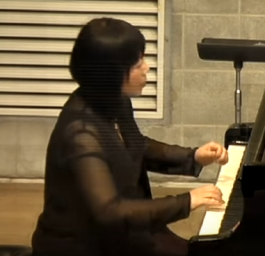
CRUMB: Makrokosmos I & II / Laurie Hudicek, pno / Intakt INN313
CRUMB: Makrokosmos I-III* / Yoshiko Shimizu, pno; *Rupert Struber, perc / Kairos 0015029
George Crumb’s Makrokosmos, written in four volumes in the early-to-mid 1970s, are among his most famous works and, I daresay, also among his most popular, if anything Crumb wrote may be said to be actually “popular.”
But of course, George Crumb is not John Corigliano, Philip Glass or Jake Heggie. His music is not based in tonality, and he calls for unusual techniques in playing (and odd vocalizations from the pianist) which many classical listeners cannot fathom and do not like. Thus it is more than a little surprising that not one but two new recordings of Makrokosmos I & II, the second release also including Music for a Summer Evening (Makrokosmos III), should appear at virtually the same time, and both are by women pianists. Dr. Laurie Hudicek is professor of piano at the University of Maryland, while Yoshiko Shimizu, sometimes known as Shimizu-Imai (on her Facebook account), is a free-lance Japanese pianist.
Crumb may indeed have named this series of pieces after Bartók’s own collection, but in truth they bear little resemblance to one another. The Bartók Mikrokosmos series contains some of his lightest and most cheerful music whereas Crumb’s series is dark, uses a great deal of space, and seems almost anti-pianistic in form. The pianist moans, shouts and whistles as he or she plays. It creates a very eerie mood, to say the least. Yet there are two quotes from Romantic-era music, the obvious one being Chopin’s Fantasie-Impromptu and the less obvious being, in “A Prophecy of Nostradamus,” the “March to the Scaffold” from Berlioz’ Symphonie Fantastique.

Laurie Hudicek
Comparing the two performances, one finds very little variance between them. This is not surprising. I’ve mentioned on several occasions that modern classical music, which in my view includes the Stravinsky, Schoenberg and Ligeti schools, tends not to be terribly open to a variance in interpretation. In a sense this is purposeful; these composers generally liked their music played, sung and conducted in a certain way, and except for Stravinsky, who became somewhat more sentimental in his late years, during which time he himself slowed down the tempi of many of his most famous works, they tried to dissuade varying approaches that were more conducive to the Romantic era. The principal difference I hear between the two recordings is the sound balance. Hudicek’s recording was made in a more ambient space, which allowed for more “binding” of one note to the next by means of the natural hall reverb, while Shimizu’s is recorded with much closer microphone placement. Yet even in her recording, there is a certain amount of reverb to be heard, although it is a little odder. In spots, such as “Pastorale (Taurus)” in the first book, the reverb almost sounds electronically enhanced, as if the engineer set up a sort of digital reverb around the piano, whereas the reverb in Hudicek’s recording sounds much more of a piece with the overall ambience of the hall in which it was made.

Yoshiko Shimizu
But this is splitting hairs. Both performances capture the mood and spirit of the music, and from what I could tell from the booklet for the Shimizu set (I was deprived of a booklet for Hudicek’s recording), the Japanese pianist has had a friendly relationship with the composer going back to at least 1981, which certainly gives her performances a stamp of authority. Yet Hudicek is also a superb performer of this music, equally committed and able to draw out the proper moods from the various pieces.
For me, then, the decision between the two sets comes down to the fact that Shimizu includes Book III, which includes a second piano (played here by Shimizu herself) and a percussionist, whereas Hudicek does not. This is the first recording of this work that uses only one pianist playing both parts. This may seem unfair to Hudicek, since the decision may well have been that of her label (Intakt) and not her own, but that’s the way the ball bounces. Of course, if you are a Crumb completist, you may certainly want to have both sets because of the extreme difference in ambience and the almost surreal effects that Hudicek created in that space. Hers is certainly a viable alternative to the Shimizu set, and does full justice to the music.
—© 2018 Lynn René Bayley
Follow me on Twitter or Facebook @Artmusiclounge
